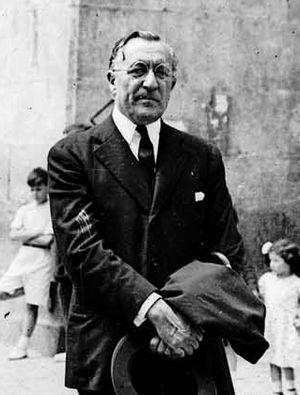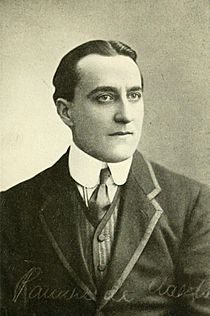Ramiro de Maeztu facts for kids
Quick facts for kids
Ramiro de Maeztu
|
|
|---|---|

Maeztu in 1934
|
|
| Ambassador to Argentina | |
| In office February 1928 – February 1930 |
|
| Member of the Cortes | |
| In office 1933–1936 |
|
| Seat L of the Real Academia Española | |
| In office 30 June 1935 – 29 October 1936 |
|
| Preceded by | Cipriano Muñoz |
| Succeeded by | Eugenio Montes |
| Personal details | |
| Born |
Ramiro de Maeztu y Whitney
4 May 1875 Vitoria, Spain |
| Died | 29 October 1936 (aged 61) Madrid, Spain |
| Political party | Patriotic Union National Monarchist Union< Spanish Renovation |
Ramiro de Maeztu y Whitney (born May 4, 1875 – died October 29, 1936) was an important Spanish writer and journalist. He wrote many essays and articles.
When he was young, he was part of a group of writers called the Generation of '98. These writers were deeply affected by Spain's defeat in the Spanish-American War. At first, he was interested in ideas like socialism, which focuses on fairness in society.
Later, he became a newspaper reporter in London. He reported on the Great War (World War I). During this time, his ideas changed. He started to believe in stronger authority and tradition.
He became a supporter of the government led by Miguel Primo de Rivera. This was a time when Spain had a dictator. Maeztu even served as Spain's Ambassador to Argentina.
He was a strong believer in military power. Towards the end of his life, he became a leading voice for the far-right in Spain. He was against the Second Spanish Republic, which was a democratic government. He even called for the military to take over.
He was part of a cultural group called Acción Española. He helped spread the idea of "Hispanidad" (which means 'Spanishness'). This idea focused on what it meant to be Spanish.
When the Spanish Civil War began, he was arrested by the Republican government. He was later killed by soldiers during the conflict.
Early Life and Writings
Ramiro de Maeztu y Whitney was born on May 4, 1875. This was in Vitoria, a city in Spain. His father, Manuel de Maeztu Rodriguez, was an engineer from Cuba. His mother, Juana Whitney, was from Nice and had a British diplomat as a father.
Maeztu was one of many young Spanish thinkers who felt sad and angry. This was because Spain lost the Spanish–American War in 1898. Other writers like José Martínez Ruiz and Pío Baroja were also part of this group. They are known as the Generation of '98.
In 1898, he published his first collection of essays. It was called Hacia otra España, which means "Towards a Different Spain."
At first, he supported socialism. This is a way of organizing society where the community owns and controls resources. But his views changed after he reported on the Great War from London. He also traveled in France and Germany during this time.
Changing Political Views
After returning to Spain, Maeztu changed many of his earlier beliefs. He started to think that human reason alone could not solve society's problems. He began to believe that strong leaders and old traditions were very important. He felt these ideas were rooted in the Roman Catholic Church.
He wrote a book in 1916 called Authority, Liberty, and Function in the Light of the War. It was first published in English. Later, it came out in Spanish as La Crisis del Humanismo (1919).
Maeztu became a strong supporter of Miguel Primo de Rivera's government. Primo de Rivera was a dictator who ruled Spain. Maeztu wanted Spain to "recover its 16th-century sense of Roman Catholic mission." This meant he wanted Spain to return to its past values and strong Catholic faith.
In 1926, he published a collection of literary essays. It was called Don Quijote, Don Juan y La Celestina. In 1928, he became Spain's ambassador to Argentina.
In 1930, he joined the National Monarchist Union. This political party followed Primo de Rivera's ideas. Other supporters of the dictatorship, like José Antonio Primo de Rivera, also joined.
In 1931, Maeztu helped create a political group called Acción Española. This group supported having a king or queen (monarchy) in Spain.
In 1934, he wrote his last book, Defensa de la Hispanidad. This means "In Defense of Spanishness." In this book, he argued for a return to "pure Spanishness." He strongly criticized liberalism and the ideas of the French Revolution. The French Revolution's motto was "liberty, equality, fraternity." Maeztu suggested his own motto: duty, hierarchy, and humanity. He believed that Spanishness was a spiritual idea that connected Spain and its former colonies. This was through the Spanish language and the Catholic faith. He thought that rational thinking and democracy were not part of the Spanish way of life.
From 1932, he wrote articles for Acción Española and the ABC newspaper. In these articles, he showed his admiration for Adolf Hitler. He also supported the anti-Jewish views of the Nazi Party. He even expressed a wish for a nationalist movement like Hitler's to succeed in Spain. He wanted it to fight against democracy and Marxism.
Death and Influence
On October 29, 1936, Maeztu was killed by Republican soldiers. This happened near Madrid during the early days of the Spanish Civil War. People say his last words were: "You do not know why you kill me, but I know why I'm dying: for your children to be better than you!"
His ideas had a big impact on the Chilean historian Jaime Eyzaguirre.
Ramiro had a younger sister named Maria de Maeztu. She was a Spanish educator and a feminist. She started important schools and clubs in Madrid. His younger brother was Gustavo de Maeztu, a painter. There is a museum named after him in Estella, Spain.
The Spanish philosopher José Ortega y Gasset dedicated his book Meditations on Quixote (1914) to Maeztu. He wrote: "To Ramiro de Maeztu, with a fraternal gesture."
Works
- (1899). Hacia otra España (Towards a Different Spain)
- (1911). La Revolución y los Intelectuales (The Revolution and the Intellectuals)
- (1916). Inglaterra en Armas (England in Arms)
- (1919). La Crisis del Humanismo (The Crisis of Humanism)
- (1920). Del Espíritu de los Vascos (On the Spirit of the Basques)
- (1926). Don Quijote, Don Juan y La Celestina
- (1934). Defensa de la Hispanidad (In Defense of Spanishness)
- (1935). La Brevedad de la Vida en la Poesía Lírica Española (The Shortness of Life in Spanish Lyric Poetry)
See also
 In Spanish: Ramiro de Maeztu para niños
In Spanish: Ramiro de Maeztu para niños



